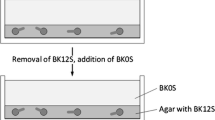Summary
-
1.
When one end of an internodial cell ofNitella is brought in contact with water, and the other end with the solution of sucrose, transcellular osmosis takes place from water side to the sucrose side.
-
2.
Accompanying transcellular osmosis, the cell sap on the water side is diluted and that on the sucrose side is concentrated. The magnitude of the polar change in sap concentration is dependent on the difference in osmotic pressure between the two external solutions.
-
3.
By tying off an internodial cell ofNitella with strips of silk thread after inducing transcellular osmosis, it is possible to produce cells having arbitrary osmotic pressures within the range of as high as 3 times and as low as 1/4 the normal level.
-
4.
The cells thus produced, which are in fact fragments of the mother internodial cell, can survive indefinitely.
-
5.
The cell, whose osmotic pressure is abnormally high or low, has a marked tendency to be restored to its normal level.
-
6.
The tendency to be restored to the normal osmotic pressure is maintained, if not fully, even when the import or export of solutes to/from the cell is prevented.
-
7.
Turgor pressure of the cell plays no essential role in the osmoregulation.
Similar content being viewed by others
References
Dutrochet, H. J., 1837: Observation sur leChara flexilis. C. r. Acad, Sci. Paris5, 775–784.
Hayashi, T., 1952: Some aspects of behavior of the protoplasmic streaming in plant cells. Bot. Mag. (Tokyo)65, 51–55.
Kamiya, N., and M. Tazawa, 1956: Studies on water permeability of a single plant cell by means of transcellular osmosis. Protoplasma (in press).
Kuroda, K.: Recherche sur la relation entre la pression osmotique de la cellule et le courant protoplasmique (in preparation).
Linsbauer, K., 1929: Untersuchungen über Plasma und Plasmaströmung inChara- Zellen. I. Beobachtungen an mechanisch und operativ beeinflußten Zellen. Protoplasma5, 563–621.
Osterhout, W. J., 1949: Movement of water in cells ofNitella. J. gen. Physiol. (Am.)32, 553–557.
Sandan, T., 1955: Physiological studies on growth and morphogenesis of the isolated plant cell cultured in vitro. I. General feature of the growth and morphogenesis of the internodial cell of Characeae. Bot. Mag. (Tokyo)68, 274–280.
Author information
Authors and Affiliations
Additional information
This work has been supported partly by a Grant for Fundamental Scientific Research from the Ministry of Education.
Rights and permissions
About this article
Cite this article
Kamiya, N., Kuroda, K. Artificial modification of the osmotic pressure of the plant cell. Protoplasma 46, 423–436 (1956). https://doi.org/10.1007/BF01248891
Received:
Issue Date:
DOI: https://doi.org/10.1007/BF01248891




